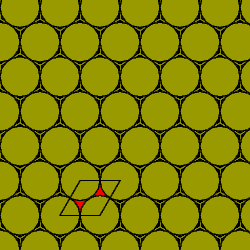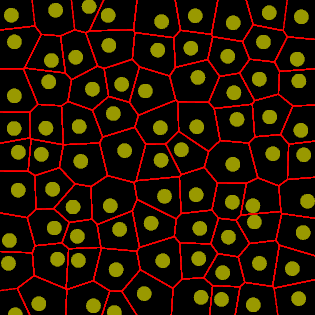3. Density
What is meant by the density of a layout of discs in the plane?
Density is measured by the fraction
of area covered by the discs.
For example, the density of the layout on
the left below is the ratio of the area of a circle to
the square which just encloses it, and the density
of the layout on the right is the ratio of the area of a circle
to that of its circumscribing regular hexagon. It is visibly
apparent, and easy to
calculate explicitly, that the density on
the right is greater. It is also easy to prove that any
lattice packing (i.e. a packing in which the discs are located
on an arithmetic lattice) has density at most that of the hexagonal
packing, as the figures illustrate.
The density of
a lattice packing is the ratio of
the area of a disc to that of a fundamental parallelogram,
and among all lattice packings with a given size disc
the hexagonal lattice clearly minimizes the
area of a suitable fundamental parallelogram.
This was observed first by Gauss.

|

|
|
The fundamental parallelogram of this lattice
is a square,
and the density of the distribution of discs
is the ratio of the area of a circle to its circumscribing square.
|
The base of the fundamental parallelogram
is necessarily the same, but its height is the smallest possible
among lattice distributions of the disc.
The density is therefore maximal among such distributions.
|
The statement of Thue's Theorem is a bit subtle, because the notion
of density for an infinite layout, other than one associated to a lattice,
is a bit subtle.
Instead of trying to define exactly what we mean by
the density of an arbitrary infinite layout, we shall
just apply one intuitive principle
which must follow from any valid definition.
|
|
Suppose we are given
a distribution of non-overlapping discs on
the plane, and suppose that the plane is partitioned into
regions (not necessarily of finite area) surrounding each disc.
For each one, calculate the ratio
of the area of the disc to the area of the region. This is the
the density of the distribution in that region.
Then, no matter what the partition is,
the density of the
overall distribution cannot be greater than
than the maximum of its densities
in the various regions.
|

The density of the distribution cannot be greater than
the maximum density among the smaller regions.
|
|
Now
we shall
associate to any distribution of
equal-sized discs in the plane a partition of the plane
into regions, with one disc in each region.
We shall prove that the proportion of disc in each of those regions
can be no more than the density of
the hexagonal packing. This will show that
no distribution will be denser than the hexagonal
packing, which is Thue's theorem.
@ Copyright 2000, American Mathematical Society. 


